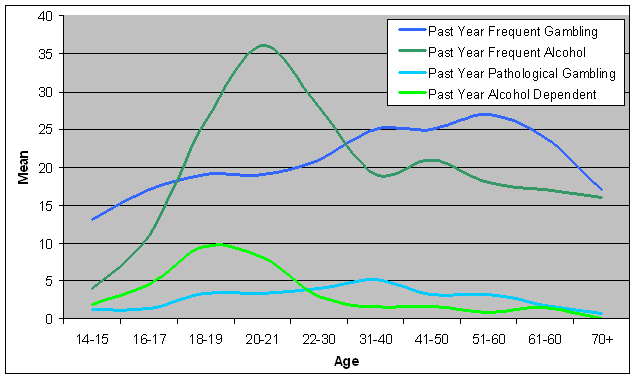The WAGER, Vol. 16(5) – Lifetime patterns of gambling and alcohol prevalence
Research suggests that youth are at increased-risk for problem behaviors (e.g., problem gambling and excessive drinking) – See The DRAM, Vol. 7(4) and The WAGER, Vol. 14(7). Although evidence suggests that the phenomenological histories (e.g., use, misuse, and seeking help) that people experience with various expressions of addiction are similar (Shaffer et al., 2004), it is unclear whether the developmental trajectories for problem behaviors are similar. This week, The WAGER reviews an article that compares patterns of gambling and alcohol use to determine prevalence trends across the lifespan (Welte, Barnes, Tidwell, & Hoffman, 2011).
Methods
- Welte et al conducted two US national telephone interviews among randomly recruited adults ages 18+ (n=2,631; 65.2% response rate) during 1999-2000 and adolescents ages 14-21 (n=2,274; 55.0% response rate) during 2005-2007.
- The surveys for both studies assessed various aspects of alcohol and gambling behavior, among other topics. This study examined:
- Alcohol – past year drinking, drinking more than one drink/day in the past year, and DSM-IV-based measures (i.e., DIS for adults, Adolescent Diagnostic Interview for adolescents) for alcohol dependence;
- Gambling – past year gambling on a multitude of gambling types for any gambling, frequent gambling (past year 52+ times), and Diagnostic Interview Schedule (DIS-IV) criteria for problem or pathological gambling. The adolescent group’s interview included an additional item about missing school because of gambling.
Results
- As Figure 1 shows, past year gambling and alcohol prevalence varied among the age groups, but the overall pattern for both measures was a rise in prevalence during teenage years, with a peak during adulthood and decline during late adulthood.
- The first graph in Figure 1 indicates a parallel pattern of change in the prevalence of gambling and alcohol use across age.
- The other graph plots frequent and problematic use. Frequent alcohol use and dependence peak for respondents 18 to 21 years old whereas for gambling these measures show muted peaks delayed to later ages.
- Except for the brief alcohol peaks, gambling measures of use and abuse exceed those of alcohol for the younger and older age groups.
Figure 1: Mean prevalence for past year gambling and alcohol use by age (adapted from Welte, et al., 2011)
Limitations
- This study used retrospective self report.
- The researchers used different dependence measuring instruments for the adolescent and adult surveys. However, the researchers designed the studies to yield comparable outcome measures.
- The adult gambling data is more than 10 years old and predates the recent proliferation in the number of land-based and Internet-based gambling sites. The gap between interviews and the associated different milieus extant at the interview period might confound results.
Discussion
The report did not examine the overlapping age group for both surveys (i.e., 18-21), which could account for potential confounding or provide important insights. However, the results indicate that past year alcohol use and gambling peak around the same age, whereas frequent drinking and alcohol dependence peak at a younger age than disordered gambling. However, alcohol use tends to taper off more quickly with age than gambling. The prevalence patterns for alcohol and gambling suggest that people might be at risk for developing problems during adolescence and into early adulthood.
-Tasha Chandler
What do you think? Please use the comment link below to provide feedback on this article.
References
Shaffer, H. J., LaPlante, D. A., LaBrie, R. A., Kidman, R. C., Donato, A. N., & Stanton, M. V. (2004). Toward a Syndrome Model of addiction: Multiple expressions, common etiology. Harvard Review of Psychiatry, 12, 367-374. doi: 10.1080/10673220490905705
Welte, J. W., Barnes, G. M., Tidwell, M.-C. O., & Hoffman, J. (2011). Gambling and problem gambling across the lifespan. Journal of Gambling Studies, 27, 49-61. doi: 10.1007/s10899-010-9195-z

